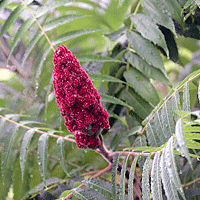Foraging for sumac – The latest restaurant trend in spices

I’d like to teach you about one of my favourite wild spices, sumac. All down the Pacific Northwest from Vancouver to Portland to San Fransisco, chefs are using local herbs and spices. Why? Because they’re freshest when you harvest from close to home. Lots of hot, new restaurants are using sumac to dust their wood fire smoked vegetables and the like; Ned Ludd in Portland, Jam Jar in Vancouver to name a few of my favourites.
Sumac is traditionally tasted in Persian or Arab cuisines on kebabs, in rice, on roasted vegetables or dusted on humus. But we can find the bright red drupes on the plants right here in North America, so let’s use them!
Food use and harvesting: Sumac has a lovely lemony flavour and great red colouring. The easiest way to use it is to dunk clean drupes (berry bunches) into water and leave them to soak. This will remove the red powder from the berries very easily. Then you can use the liquid to cook with, add it to rice, make cocktails with it or use it to make Za’atar (A tasty Arabian spice blend). The plants are easy to recognize, harvest from either a smooth sumac (Rhus glabra) or the staghorn sumac (Rhus typhina) as there are many different species. The staghorn sumac is the one you’ll find around Vancouver to harvest from most frequently (make sure you ask your neighbour if you can grabe a drupe first though!).
Note: Mainly on the East Coast, Poison Sumac (Rhus vernix) is a much smaller shub and toxic cousin which usually grows in swamps, bogs, and low moist areas, often in the shade of taller trees and has white drupes.
To learn more about how to safely forage for wild ingredients in the Pacific Northwest, check out our Free video series: Foraging 101
Have fun,
Chef Robin
